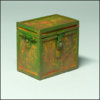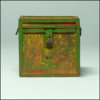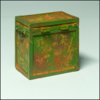S
Stevekir
Guest



I scratch built (my first attempt) this little box to experiment with rust. It is 3 cm by 3 cm by 2 cm front to back. At 1/24 scale it would in the original be 75 cm (30 inches) long and is intended to be a workman’s tool box bolted to a flatbed trailer (part of a coming model), made of angle iron and sheet steel riveted together, and permanently exposed to the weather.
I first experimented on a strip of styrene sheet with 2 mm strips to represent the angle iron. Because of incompatibility between paint & paint and paints & varnish, Humbrol Matt Cote and its thinners were used (the second seems to be White Sprit) at this experimental stage. The rust used was Mig Pigments Rust (P025) and Light Rust (P024). The pigments mixed with thinned Matt Cote were painted on by bristle brush to give a mottled look. When thoroughly dry a coat of Matt Cote was brushed on to fix the rust.
I tried the salt and Maskol methods of getting a finish with rusty patches, and the Internet videos show these methods give very realistic results. However, there was a scale problem. The salt grains were too big for this little object and grains small enough were almost powder. Maskol, being a thick (viscous) liquid, I found that blobs of it small enough for the model were too small and thin to be reliably rubbed off using the usual white tack without stripping the overlying colour layer. (See note ** at end about this.)
Another approach. A coat of Vallejo Model Color German Camo Green was painted on another primed styrene test piece. Using a fine bristle brush, Matt Cote with particles of the two rust colours (each separately) fully mixed in was painted on in as in the Humbrol video. The result looked what it was – painted on. Some rust is three dimensional, so I tried painting on little patches of Matt Cote (no pigment) and dropping grains of rust pigment on to them. It gave a granular surface like rust can produce. This seemed to work but when I added a final coat of Matt varnish (to allow safe handling) the pigment grains looked shiny. So back to the drawing board
I changed methods and tackled finishing the model itself, by first brush coating all over with Vallejo Model Color German Camo Green. The rivets were positioned one-by-one using sheet AR88001 by Archer Fine Transfers. (These are 3D objects on a decal sheet and are applied just like conventional decals are.) Being applied over the matt coat (the green), as expected the transparent parts of the decal reflected light (silvering).
The handles and the padlock were chromed but this does not show well in the photos. Then the model was covered with a coat of Tamiya Clear Matt (TS80, spray can) and allowed to dry. The silvering disappeared. Minute amounts of the dry pigment powders were added on a pointed toothpick or cocktail stick to the top edges of the horizontal angle irons and applied (by pressing, not rubbing) followed by a shake (don’t blow, it goes everywhere) and a very light brushing to remove loose particles. For the panels, the two pigments were sprinkled on from a dry brush knocked by another brush’s handle, then a small conical-ended cotton bud used to press (not rub) them on (a rounded cocktail stick would do). In some places I pressed the pigment with my finger. After a shake and a very light brushing to remove loose particles, they stayed put. A tiny amount of weathering was added. Finally, another coat of Tamiya Clear Matt (TS80) was sprayed to fix and allow handling.
>> So what do you think?
>> Does it look like real rust?
>> What would you have done to add rust to this sort of model?
>> How could I have made it look more like painted steel than painted plastic?
>> (I didn’t dry brush the model.)
** NOTE I was puzzled about the scale problem. The salt and Maskol methods are routinely used to add rust to 1/72 models, usually tanks and planes, which are 1/3 the scale of my box, so why were they out of scale for my model?. I think the answer is that models of tanks and planes, although at the smaller scale, are bigger objects than my little box, offering several larger areas (on the actual models) for adding salt- and Maskol-sized rust patches.
Also, the red pigments get everywhere: on hands, desk, tools, models etc. Be careful. Don’t sneeze.


 :D
:D